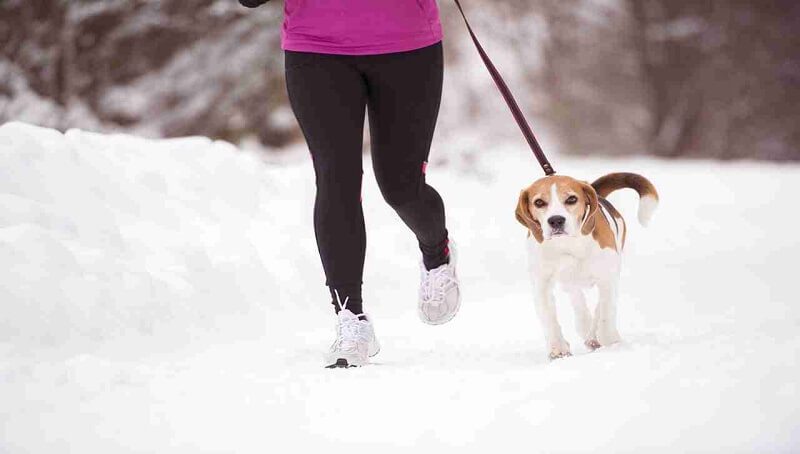
Bobcat Facts & Information – Discover A Stealthy North American Predator
September 28, 2022
Winter Dog Walking Tips
September 29, 2022
Is your dog fat or about to become obese?
In America, it has been estimated that half of all pets, dogs and cats, are obese. It is a problem that slowly and surely can become lethal for these fur balls that we love.
It may seem difficult at first, not to give them food when they want, but like people, the fatter they are, the more they suffer and live less.
Dr. Ernie is the founder and president of the Association for Pet Obesity Prevention – I didn’t even know there was one. He says many pets are so obese that they won’t live as long as their parents.
What can we do to change that?
The first step is always education. In order to help our pets, we have to take into account the risk factors.
4 risk factors for obesity
- Parents with weight
The truth is that if you have a weight problem, chances are your dog will.
Most owners can’t help but feed their pets when they eat. A snack here and there, and the tasting meals lead to fat deposits, especially if the furry pet is not active.
- Breed
Some breeds of dogs are prone to obesity.
The Labrador is one of the most obese races. He loves to eat and sleep, but they can also easily consume calories well above their needs if given the opportunity.
You might also like my articles on whether dogs can eat chocolate, ham bones, or mandarin oranges.
Other breeds prone to obesity are: English Spanish Cocker, Teckel, Rottweiler, Golden Retriever, and Dalmatian.
- Food at its discretion
 Any dog breeder will tell you, if you ask him, that offering food at its discretion is not recommended.
Any dog breeder will tell you, if you ask him, that offering food at its discretion is not recommended.
If you leave food in the bowl all the time, your dog will eat when he is bored, lonely, stressed, or hungry.
Food gives a pleasant feeling; when you quench your appetite, you feel good, right? This is what the animal thinks and whenever it has the opportunity it returns to the bowl of food.
Dogs do not have good appetite control. Instinct tells them to eat when food is available to make calorie deposits.
Domestic dogs nowadays don’t know what it’s like to have no food, so they will eat all the time.
- The overfed
Even if they don’t leave food in the bowl, many owners don’t know how many calories their dog needs to consume.
They’re eye-measuring how much a dog should eat. If you have more than one dog, it is difficult to estimate.
How do you help a dog lose weight?
One study found that a dog with a normal weight lives an average of 2 years longer than a fat dog.
In addition, he will not suffer from problems due to obesity such as:
- Problems with the joints
- Pain
- Diabetes
- Arthritis
- Heart problems
- High voltage
- Difficult breathing
- Problems with the liver
- Digestive problems
- Low immunity
- High risk of cancer
If you have a fat dog, as its owner, you need to make him eat less and exercise a lot more. The easiest way is to go to a veterinarian to establish a diet.
They have to move and play more. Try new toys and spend an extra 10 minutes with them every day. Every type of exercise or activity matters, no matter how small or easy it is.
Proper and controlled feeding
Controlling the portion of food is the key to healthy eating. If you feed your pet dry food, you will find the recommended daily portion on the food bag. Even if these portions are only general quantities, they can be used as an estimate. Your dog is unique and has characteristics that you need to consider, so we recommend you consult with your current veterinarian.
Dog food calculator
Like humans and all other animals, dogs also need a certain number of calories to maintain proper energy and body mass. To determine a dog’s caloric needs, the dog’s resting energy needs (RER) and maintenance energy needs (MER) should be calculated from the dog’s weight in kilograms.
To calculate the kg, divide the weight in pounds into kilograms by 2,2. For example, a 22-pound dog weighs 10 kg. A 60-lb dog weighs 4,5 kg. A 100-lb dog weighs 27 kg.
The resting energy requirement, or RER, is the basic energy needed to support essential body functions such as metabolism, circulation, breathing, and digestion. To calculate RER, multiply 70 by body weight in kilograms raised to 3/4 power.
70 * (BWkg)0,75 = RER (kcal/day)
Once you find your pet is obese/overweight, you can start with these steps:
- Eliminate rewards
You can start to improve his diet with the elimination of rewards. Consider each reward your dog receives during the day. Either he gets some of your food while you eat, or another family member rewards him. You can replace treats with healthy alternatives like vegetables but in controlled quantities.
- Reduce the daily portion of food
You can try reducing his daily portion of food. It is recommended to give him 15-20% less food over a 6-8-week period and analyze the results. It is best to consult with your veterinarian, who will be able to determine exactly how much you need to reduce considering your dog’s ideal weight, age, and other factors.
- Choose a dietary food
Another alternative to a dog’s diet is changing food. A diet food contains fewer calories but still provides a healthy diet for your dog. You can change your dog’s usual food with this food and give it in amounts recommended by the manufacturer or veterinarian.
- Give your dog the chance to have regular movement
Regular exercise is very important for every dog, especially if it is fat. Besides controlling its food, you must introduce more daily movement for your dog. Start with at least 10-15 minutes of exercise. This can be walking, playing, and swimming if it’s an older dog.
You also want your dog to be healthy. Control his weight so that it is at the optimal level and you will avoid many inconveniences!
